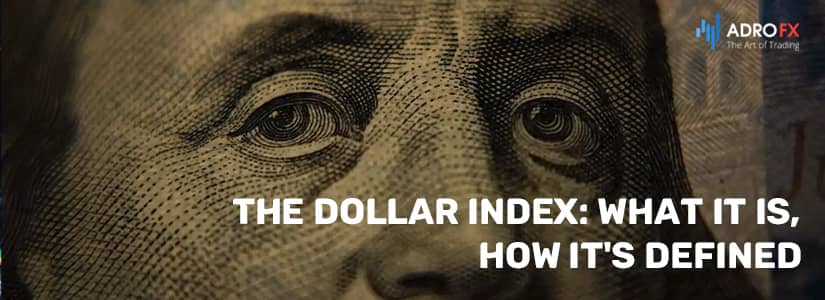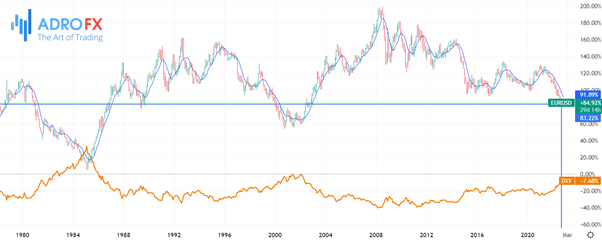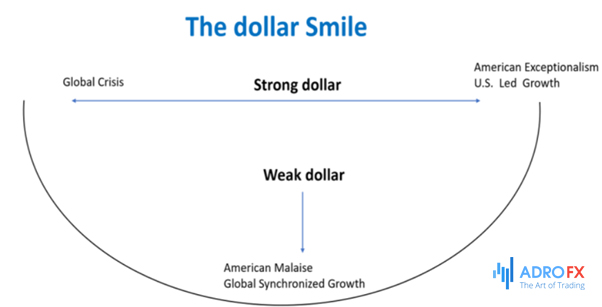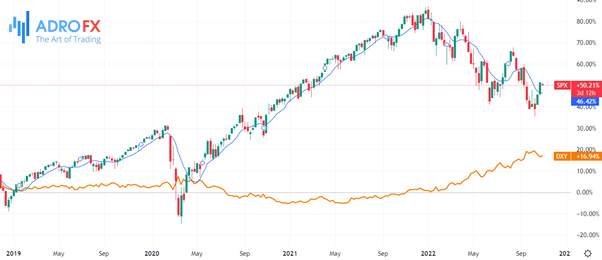The Dollar Index: What It Is, How It's Defined

Investors rely on a variety of tools in an attempt to determine the current and future state of the market. This set includes synthetic ones, such as stock indices, which allow evaluating the situation as a whole, without losing time analyzing a multitude of individual assets. Among the many indices used in the stock market, the dollar index stands out. What is it and how to use it in investments?
What is Dollar Index?
The U.S. Dollar Index (USDX or DXY) is a measure of the value of the U.S. dollar relative to other currencies. The stronger the dollar is relative to them, the higher the index will be.

The index is calculated as a geometric weighted average of the U.S. dollar (USD) to a basket of six foreign currencies:
- Euro (EUR) – 57.6%
- Japanese Yen (JPY) – 13,6%
- Pound Sterling (GBP) – 11.9%
- Canadian Dollar (CAD) – 9,1%
- Swedish krone (SEK) – 4.2%
- Swiss franc (CHF) – 3.6%
The choice of these currencies did not fall by chance – at the time of the creation of the JP Morgan index in 1973, they were the first in the foreign trade turnover of the United States. Since then the index structure was revised only once - when it took the place of the German mark with the introduction of the single European currency.
Weights of the basket currencies (degree indices for each pair) were calculated in proportion to their contribution to foreign trade operations. The first coefficient is selected to bring the index value at the moment of its introduction (after the adoption of the Smithsonian agreement, by which the exchange rates became floating) to 100%.
Thus, the dynamics of DXY quite adequately reflect changes in the value of the U.S. currency in the world market.
The Dollar Index created by JP Morgan is still widely used today. But due to the changed economic situation, its accuracy of showing dollar value in the world has decreased significantly. For example, the CNY is not included in its calculation while China has become one of the largest trading partners of the U.S. To improve accuracy, the Fed is actively working with its modified counterpart - TWDI (Trade-Weighted Dollar Index), which uses an expanded basket of almost 30 currencies in its calculation.
Because it is an index, it works similarly to the FTSE 100 or S&P500 indices, but instead of being a barometer for the stock market, it shows the relative strength of the U.S. dollar. The index is maintained and published by the world's largest futures market operator Intercontinental Exchange Inc (ICE) and is calculated every 15 seconds.
Many traders and economists believe the U.S. dollar index basket should be updated to reflect the fact that the United States now trades more with countries such as China, South Korea, Mexico, and Brazil, and trades less with countries such as Switzerland and Sweden.
The U.S. dollar is the world's reserve currency, widely traded and of interest to traders around the world. This currency accounts for 88% of forex trading according to a survey by the Bank of Central Reports
The U.S. dollar has a rather unique feature in that it tends to rise in times of uncertainty in world markets, as well as during the growth of the American economy. As a result, the dollar forms well-established trends that experienced traders can take advantage of.
The dollar index futures are traded on the Intercontinental Exchange (ICE) 21 hours a day and can be traded through many forex and CFD brokers.
History of the US Dollar Index
The U.S. Dollar Index has risen and fallen sharply throughout its history, peaking in February 1985 with a value of 164.72 and hitting a low in March 2008 with a value of 70.698. As of March 25, 2020, the index had a value of 100.35, which means that the U.S. dollar has depreciated against a basket of currencies since 1985, but is roughly equal to its starting value in 1973. The index is strongly influenced by macroeconomic factors, including inflation/deflation of the dollar and foreign currencies included in the comparable basket, as well as recessions and economic growth in those countries.
The composition of the currency basket has been changed only once since the index was launched, when the euro replaced many European currencies previously included in the index in 1999, such as Germany's predecessor currency, the German mark. Currencies are likely to be replaced in the coming years as the index seeks to represent major U.S. trading partners. Likely, currencies such as the Chinese yuan (CNY) and Mexican peso (MXN) will displace other currencies in the index in the future, as China and Mexico are major U.S. trading partners.
Why the Dollar Index is Needed
The DXY index gives a general idea of the international value of the U.S. dollar, but its value declines amid changes in the global economy. For example, the basket does not include China's currency, while the PRC is one of the largest trading partners of the United States. Nevertheless, the index is useful because it shows a more complete picture than any of the currency pairs individually.
The U.S. Dollar Index is available for trading on all 5 business days of the week. Trades can be made through futures contracts and ETFs.
The largest volume of options and futures trading is concentrated at Intercontinental Exchange (ICE) in London, the ticker of the contract is DX, and expiration occurs once a quarter. And funds working with DXY as an underlying asset are traded on foreign stock markets.
DXY index not only acts as an independent trading tool but also serves as an indicator that allows you to predict the change or continuation of the trend.
Why Is the DXY Index Up and Down?
A strong national currency benefits importers and disadvantages exporters. And vice versa.
Let's imagine that a Canadian exporter sells oil to a foreign market. The oil is sold in dollars, so they will receive payment for exports in dollars. Suppose they sell 1,000 units at $1 each. If the USD/CAD exchange rate is 1.37, the return will be 1,370 when converted into Canadian currency. If the exchange rate is 1.6 Canadian dollars per US dollar, the gain will increase.
In this example, the national currency is the Canadian dollar. The change in the exchange rate from 1.37 to 1.6 shows the weakening of the national currency against the dollar. This is beneficial for exporters. If the exchange rate had strengthened from 1.37 to 1.00, they would have lost almost a third of their income.
The opposite situation is typical for importers. Their task is to buy cheaply from abroad and sell successfully in the national economy. The importer buys products in foreign currency (for example, he buys Italian cheeses from Italians - for euros, of course), so it is beneficial for them to give less for the same amount of goods.
Let's go back to the example of cheeses: let's say a batch of cheeses costs 5,000 euros. At the EUR/CAD exchange rate of 1.35, the batch is worth 6,750 Canadian dollars. At the exchange rate of 1.2, it is worth 6,000. And so on.
If the exchange rate of the national currency weakens (in this case, if they are asking not 1.35 Canadian dollars for 1 euro, but 1.5), then the foreign product batch becomes more expensive. Gradually it becomes uncompetitive, as other domestic producers supply it to store shelves cheaper. Therefore, importers advocate a strong national currency exchange rate.
The country's central bank is therefore constantly looking for a balance to meet the interests of different economic players and trying to prevent economic shocks. That is why the exchange rate fluctuates constantly.
What Factors Affect Changes in the DXY Index?
The dollar index is subject to both cyclical changes caused by U.S. monetary policy adjustments and more speculative sentiment.
Let's look below at the main factors that affect its change.
• Cash supply in the U.S.
The more dollars printed, the weaker their strength, all other things being equal. A weaker dollar means a decline in DXY, that is, a change from, say, 92.0 to 89.0.
Other conditions mean that the weakening of the dollar does not occur against an even greater weakening of other currencies. Because in this case, even a historically gigantic USD issue will not cause a decline in the U.S. currency if the other currencies depreciate even more.
To understand, let us imagine an example that there are 1,000 USD units and 10,000 EUR units. Then there will be 10 EUR for 1 USD. Let us imagine that there are 1,000 more USD printed. Then 1 USD equals 5 EUR. After this issue, the U.S. dollar weakened against the euro. And the euro strengthened against the U.S. dollar.
• The key interest rate of the Fed
Here we are talking about the attractiveness of investing in assets denominated in dollars. Primarily in U.S. Treasuries, also called Treasuries.
If the interest rate goes up, then, other things being equal, the yield on U.S. Treasuries goes up. Other conditions here refer to the market value of the bonds themselves - they may have partially "adjusted" in advance for future rate changes and adjusted yields.
Rising yields mean that foreign investors will be eager to exchange their national currency for dollars to invest in bonds. In other words, it increases demand for the U.S. dollar.
Increased demand for the dollar will lead to a strengthening of the dollar. That is, the USDX index will rise.
• The attractiveness of the U.S. economy to foreign investors
This point is similar in principle to the one above. The exception is that it is not just the interest rate that makes an economy attractive to foreign investors.
Growth of the stock market, higher GDP growth, lower unemployment, successful targeting of inflation (when it is in the range favorable to the Fed), increasing disposable income and consumption, the growth of individual industries: construction, industry, information technology, and others - all these points to the fact that the United States is worth investing in.
Then foreign investors buy shares of relevant companies or ETFs, characterizing the success of individual sectors. To do this, investors need to buy dollars. This stimulates demand for them. And it leads to a strengthening of the USD - that is, the DXY index rises.
• Demand and supply of the Euro currency
The EUR/USD exchange rate is more than 50% of the U.S. dollar index. Therefore, almost any event concerning the Euro automatically affects the DXY.
We will consider them in more detail below.
Why the DXY Dollar Index Correlates So Much with the EUR/USD
EUR/USD currency pair weight in the dollar index is 57.6%. This characterizes the high dependence of the DXY index on the Eurozone monetary policy and other euro currency sentiment. The chart below shows the dynamics of both instruments over the 20 years since:

It is easy to see that the instruments are moving almost synchronously in the opposite direction. If one is rising, the other is falling.
It should be noted that the charts are plotted at the close prices (Close) of the monthly candlesticks (MN1). This means that the global trend of these assets is almost completely multidirectional: the first one is growing, so the second one is falling, and vice versa. In this case, local fluctuations (on M1, M15, H1, etc.) can differ more considerably.
The correlation is the strength of the relationship between the phenomena and can take values from "1" to "-1".
The value "1" characterizes the absolute one hundred percent direct correlation. That is, if one asset increases by n%, then the second asset will also change by n%.
A value of "0" indicates a complete absence of correlation. In other words, there is no similarity between the assets at any point in time.
A value of "-1" reflects an absolute 100% inverse relationship. When one asset grows by n%, the other asset decreases by n%.
We can see that there is almost one hundred percent negative correlation between the dollar index and the EUR/USD pair - to be precise, it is "-98.15%". This confirms the fact that the assets are moving almost simultaneously.
But why is there such a high correlation, when EUR/USD is only 57.6% of the USDX?
First, the likely reason is that of the six currency pairs that make up the USDX index, four pairs represent the European region. They together account for 77.3% of the weights of the entire index. These pairs are EUR/USD, GBP/USD, USD/SEK, and USD/CHF.
A close relationship between European economies and their high interdependence between them causes their movements to be more or less synchronous.
Secondly, it is a combination of the European and American sessions that give the greatest volatility. In other words, the Japanese yen is unable to have a significant impact on the dollar index, as it does not show great movements.
European currencies are more volatile, so they take on a major share of DXY index movements.
The Dollar Smile Theory
The dollar is a very interesting currency, it can strengthen in both bad and good economic conditions. As a result, one of Morgan Stanley's employees somehow came up with a fundamental theory that helps explain this phenomenon. It was Stephen Jen, an economist, and currency analyst. His theory is called the "dollar smile theory." The essence of the theory is that the U.S. dollar in all its diversity always adheres to only three scenarios.

The first part of the smile implies a situation where investors are looking for a "safe haven" for their funds held in dollars and yen. Because investors believe that the global economy is slowing down, they are in no hurry to buy risky assets and prefer to invest in less risky dollar assets, even if the U.S. economy is not doing particularly well.
The second scenario is when the dollar falls hard, updating lows. This is the bottom of the smile, which suggests that the U.S. economy is weak, just as its national currency is weak. In this scenario, it is not uncommon for discount rates to decrease, which can also affect the dollar's depreciation. As a result, the market gets rid of the dollar and the smile gets wider.
And we thus move on to the third scenario. The dollar is loved and respected again, thanks to economic growth in the U.S. There is more optimism, traders are beginning to buy dollar assets, U.S. GDP is growing, and key rates are expected to rise.
A prime example of this theory is the crisis of 2007. In 2008, at the peak of the economic crisis, the dollar began to strengthen sharply - investors fled from the global fire to the strong currency, triggering the first scenario. Then, in March 2009, investors switched to higher-yielding currencies and the dollar showed an impressive drop. That was the second scenario, after which the third scenario was triggered - a new rise in the dollar that lasted until the summer of 2010, after which the cycle repeated itself.
How Do You Use the US Dollar Index in Trading?
Today, traders in financial markets use the dollar index quite widely as a tool:
- indicative in currency trading;
- a base tool for derivatives on the futures market;
- the base for index funds (ETF).
USDX in the foreign exchange market
On the international currency market, the dollar index works as a tool to assess what has become the source of quotation dynamics of a currency pair. For example, a situation when EUR/USD is growing and the dollar index keeps undirected (sideways) movement allows us to make two useful conclusions at once:
The change in the exchange rate is caused by the demand on the part of traders exactly for the euro.
You can pay attention to other pairs with EUR, where similar processes can be observed.
As the euro/dollar pair has the largest weight in the basket and accordingly the maximum influence on the DXY dynamics, an inverse correlation with a coefficient close to -1 can be observed for these assets as a rule. In this situation, a deviation from the standard pattern provides signals that are assessed as strong.
Another variant of using the dollar index in foreign exchange market trading is leading signals for assets that do not participate in the calculation. Indeed, major players who monitor the USDX are ready to respond to its dynamics, opening the corresponding positions on currency pairs. This in turn leads to changes in the quotes (the mechanism of self-fulfilling prophecy kicks in).
The dollar index on the derivatives market
Like any exchange index, the USDX becomes a base for contracts on the futures market. The main one is the futures on the dollar index with the ticker DX traded at the ICE (Intercontinental Exchange, an association of trading platforms from different countries, which allows trading almost around the clock).
The contract size for it is 1000 × the current value of the index, expiring once a quarter in March, June, September, and December.
The dollar index and the stock market
The dollar index is also traded on the stock market. Thus, there are three ETFs in the Arca section of the NYCE (New York Stock Exchange) for which DXY acts as an underlying asset or one of the following:
UUP – PowerShares DB US Dollar Index Bullish ETF – replicates the structure of the index when rising.
FSU – FactorShares 2X S&P500 Bull/USD Bear ETF – based on the S&P500 in a bull market and the dollar index in a bear market.
UDN – PowerShares US Dollar Bearish ETF – opposite UUP, copies the structure of the index when declining.
It is not rational to include these indices in a portfolio as working investment assets. They are mainly designed for hedging and you will not capitalize on them. But they will be a good defense during "storms" in the commodities market (especially in oil trading) and the stock market.
The dollar index and securities
The Dollar Index, reflecting the value of the U.S. currency, can serve as a valuable source of information for stock market investors working with stocks, bonds, equities, and other assets.
Thus, the rise in the USDX reflects several important facts:
- a decline in gains for global corporations that derive a significant portion of their revenue from outside the U.S;
- a decline in the competitive advantage of export-oriented U.S. companies due to rising costs;
- an increase in the price of investing in U.S. markets (including securities) for foreign investors.
This set indicates that the growth of the dollar index is a signal indicating a weakening of the U.S. stock market. The calculation of the correlation between the S&P500 and the USDX also confirms this. It is inverse and its coefficient has risen considerably in the last few years.

However, all is not so clear-cut. A rise in the dollar index at the same time suggests that the U.S. economy is growing (or recovering) faster than the global economy. A weakening of the U.S. currency, on the other hand, maybe an indication of problems in the country, which is not conducive to the strengthening of stock markets.
Thus, when investing in stocks and other securities, it is very useful to analyze the behavior of the dollar index. However, because it gives contradictory signals, you will also need to analyze the reasons for these dynamics.
How to Analyze the Dollar Index?
Traders can use movements in the index to get an idea of how the U.S. dollar is changing against major currencies. For example, if the USDX is rising, the U.S. dollar is likely to rise as well. Conversely, if the USDX is falling, the dollar is also likely to fall.
Many financial media outlets report changes in the USDX to give their audiences an idea of how the U.S. dollar has performed in the forex market.
The USDX can also be used as a reverse indicator of European Union currency strength, as the euro has an overwhelming 57.6 percent in the index. The next highest-weighting currency in the index is the Japanese Yen, which has an overwhelming 13.6 percent.

The next key thing traders should keep in mind is how movements in the U.S. dollar index correlate with the movements of quoted currencies against the dollar. For example, if a currency pair is quoted as USD/JPY, then the USDX and that currency pair must have a positive correlation, meaning they must be rising and falling at the same time.
Conversely, when a currency pair is quoted as EUR/USD, this currency pair has an inverse correlation. That is, it should move in the opposite direction when the dollar is rising, and, respectively, fall when it is rising.
Interpretation of the US Dollar Index Index
The value of the 120 index implies that the U.S. dollar has gained 20% over a basket of currencies over the time period in question. Simply put, if the U.S. dollar is rising, it means that the U.S. dollar is gaining strength or value relative to other currencies. Similarly, if the index is currently at 80, which is 20 below its original value, it means that it has depreciated by 20%. The results of appreciation and depreciation are a factor in the period in question.
About AdroFx
Established in 2018, AdroFx is known for its high technology and its ability to deliver high-quality brokerage services in more than 200 countries around the world. AdroFx makes every effort to keep its customers satisfied and to meet all the trading needs of any trader. With the five types of trading accounts, we have all it takes to fit any traders` needs and styles. The company provides access to 115+ trading instruments, including currencies, metals, stocks, and cryptocurrencies, which make it possible to make the most out of trading on the financial markets. Considering all the above, AdroFx is the perfect variant for anyone who doesn't settle for less than the best.










